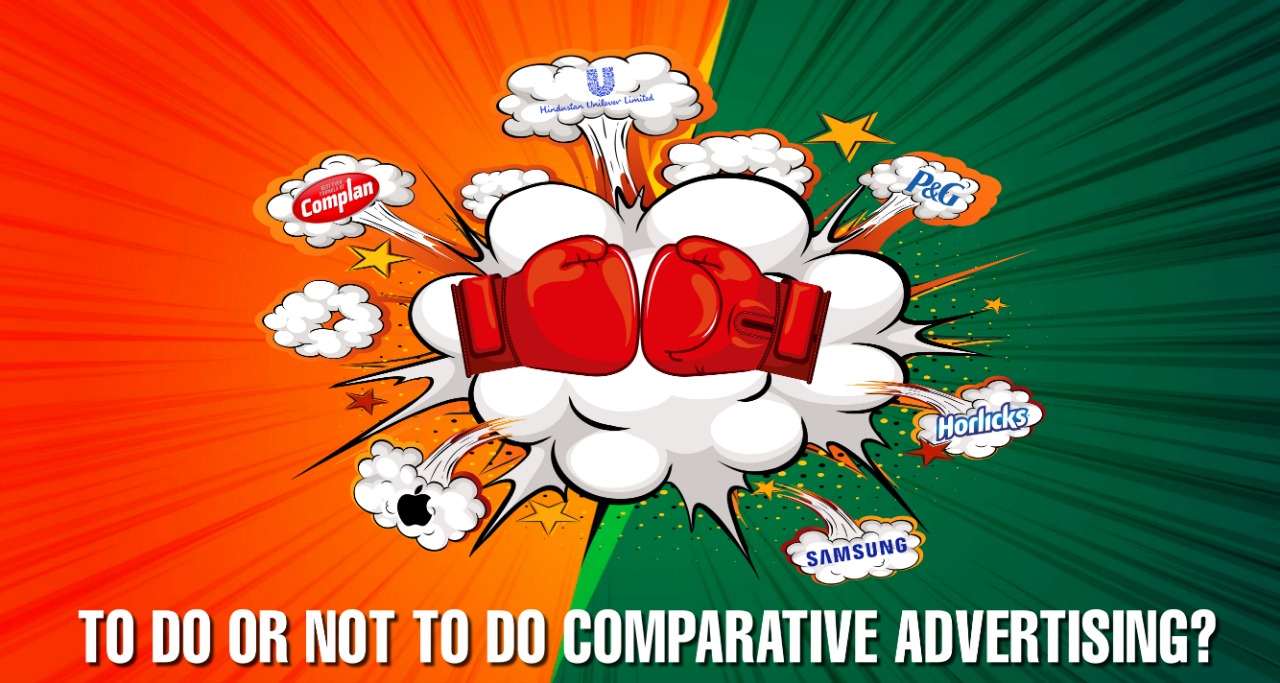
To Do or Not To Do Comparative Advertising?
In the constant search for successful advertising & marketing strategies, we’ve brought you a volatile subject for you this time. If done correctly, the possibility of reaching new heights in this campaign is endless. But if you touch the wrong chord, then you risk the chance of losing massively! Many brands steer clear of this advertising tactic. But the ones who have been successful in this have made it big and are now known all over the world. It is surely not for the faint-hearted. Let’s dive deep into the topic and learn more about it.
The controversial strategy that we are talking about is “Comparative Advertising”. It generally focuses on one particular product or service of a brand. Very self-explanatory in nature, this strategy’s main strength is the comparison with a similar product or service of its rival brand. Apart from addressing the main pain points of consumers, this type of advertising highlights why it is better than its competitors. This display of superior advertising garners brilliant brand awareness & attention. However, all of that attention may not be good. Sometimes, comparative advertising is frowned upon. With every campaign, there are bound to be people who disagree with it. That’s a subjective matter that we leave for you to decide.
This isn’t a recent phenomenon though. Comparative advertising has been in the mainstream since the 1960s. Starting in the US, it slowly found its way into the Indian market. Now, outrightly targetting the rival brand and using their names as inferior brands is illegal through advertising laws in almost all countries. But copywriters and creative directors sure found a loophole around it. In any comparative ad they made, instead of showing the exact rival product, they showed similar ones that were easily identifiable by the audience by their colour, packaging or homonyms. That way, they avoided lawsuits while making the ads.
Tata & Captain Cook’s Salt War
One of the early examples of comparative advertising in India is the brand war between Tata Salt & Captain Cook Salt. While Tata Salt took the health awareness way to highlight its product, Captain Cook focused on the serene experience and easiness of using its salt in the ad.
Needless to say, Tata Salt won the war as you know it still dominates as the No.1 salt brand in the nation. One of the major reasons for that is roping in popular actor and multiple National Film Award winner Pankaj Kapur. But we’ll give our brownie points to Captain Cook & Sushmita Mukherjee for a hilarious ad.
Horlicks Vs Complan
The two big names in nutrition drinks for kids also had a spat of ads trying to win the upper hand back in 2008. While Complan’s USP has been double growth for kids since the 90s, Horlicks one-upped them with a “Taller, Stronger, Sharper” campaign.
Horlicks had the win between the two brands for quite a while because of its budget pricing and multiple benefits. Complan is still trying to reach up there with new flavours and high-nutrition value. But the battle has been subdued with the arrival of brilliant campaigns from Bournvita recently.
Pros & Cons of Comparative Advertising
While comparative advertising yields high rewards, we cannot ignore the risk that comes with it. Therefore, we have come up with a pros and cons list that will help you decide whether you should venture into comparative advertising or not.
Pros
Excellent Brand Awareness
You must have heard of the saying “Fortune Favours the Bold”. If you tread on this strategy’s path, you will surely enjoy the benefits of excellent brand awareness. People are always looking for something new & unique. If your product or service is better enough to challenge the top shelf of the market, people will take notice. That’s how you can sway a lot of new customers to your brand.
Focused Product Emphasis
Even if your strategy fails to register a perfect win because crossing paths with the market monopolies can be a humungous task, your singular product will still win. Comparison in its essence will make sure people understand that your product is superior to the other brands out there. Therefore, the overall sales of the product will increase and that’s a good win you should take any day.
Consumer Awareness to Increase Customers
When your comparative ad gets viral, the main pain points of the customers that were not met by the other brand will be fulfilled by yours. That positive remark will encourage them to switch and you will gain a big customer base from this.
Cons
Legal Consequences
Comparative advertising can be dangerous if not done correctly. Therefore, you need to strategise with utmost care and responsibility. Many countries have laws protecting brands and consumers from comparative advertising. Also, if you’re a big-name brand, the media is likely to jump on your back for reporting as well.
Brand Integrity Loss
Even though comparative advertising is controversial, you should always avoid cheap tactics. Your job is to place your product as superior not claim that other brands are inferior. This strategy might result in losing brand integrity and the customers’ trust.
So here is the complete analysis of the comparative advertising strategy. High risk can yield high rewards. But it also can go south pretty fast if you’re not careful enough. So which path are you gonna take? Will you have “Risk hai toh Ishq Hai” or “Play it Safe”? Let us know in the comments below. Keep following Sanket’s blog page to read more about new and unique advertising strategies and stories.
About Author
Sandeep Hati is a copywriter at Sanket Communications. He is passionate about advertising trends and stories. He aims to explain the many intricacies that run the advertising and marketing world. When he’s not working, you’ll find him buried in a book or watching period cinema or failing gloriously on the same level of video game infinitely.




